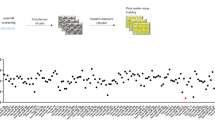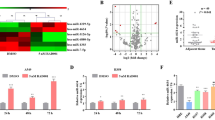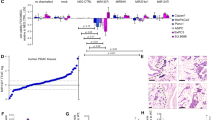Abstract
Targeted cancer therapies, although often effective, have limited utility owing to preexisting primary or acquired secondary resistance. Consequently, agents are sometimes used in combination to simultaneously affect multiple targets. MicroRNA mimics are excellent therapeutic candidates because of their ability to repress multiple oncogenic pathways at once. Here we treated the aggressive Kras;p53 non-small cell lung cancer mouse model and demonstrated efficacy with a combination of two tumor-suppressive microRNAs (miRNAs). Systemic nanodelivery of miR-34 and let-7 suppressed tumor growth leading to survival advantage. This combinatorial miRNA therapeutic approach engages numerous components of tumor cell-addictive pathways and highlights the ability to deliver multiple miRNAs in a safe and effective manner to target lung tissue.
This is a preview of subscription content, access via your institution
Access options
Subscribe to this journal
Receive 50 print issues and online access
$259.00 per year
only $5.18 per issue
Buy this article
- Purchase on Springer Link
- Instant access to full article PDF
Prices may be subject to local taxes which are calculated during checkout




Similar content being viewed by others
References
National Lung Screening Trial Research Team, National Lung Screening Trial Research Team Aberle DR, National Lung Screening Trial Research Team Berg CD, National Lung Screening Trial Research Team Black WC, National Lung Screening Trial Research Team Church TR, National Lung Screening Trial Research Team Fagerstrom RM et al. The National Lung Screening Trial: overview and study design. Radiology 2011; 258: 243–253.
Yanaihara N, Caplen N, Bowman E, Seike M, Kumamoto K, Yi M et al. Unique microRNA molecular profiles in lung cancer diagnosis and prognosis. Cancer Cell 2006; 9: 189–198.
Lin P-Y, Yu S-L, Yang P-C . MicroRNA in lung cancer. Br J Cancer 2010; 103: 1144–1148.
Johnson SM, Grosshans H, Shingara J, Byrom M, Jarvis R, Cheng A et al. RAS is regulated by the let-7 microRNA family. Cell 2005; 120: 635–647.
Takamizawa J, Konishi H, Yanagisawa K, Tomida S, Osada H, Endoh H et al. Reduced expression of the let-7 microRNAs in human lung cancers in association with shortened postoperative survival. Cancer Res 2004; 64: 3753–3756.
Bommer GT, Gerin I, Feng Y, Kaczorowski AJ, Kuick R, Love RE et al. p53-mediated activation of miRNA34 candidate tumor-suppressor genes. Curr Biol 2007; 17: 1298–1307.
Lodygin D, Lodygin D, Tarasov V, Tarasov V, Epanchintsev A, Epanchintsev A et al. Inactivation of miR-34a by aberrant CpG methylation in multiple types of cancer. Cell Cycle 2008; 7: 2591–2600.
Gallardo E, Navarro A, Viñolas N, Marrades RM, Diaz T, Gel B et al. miR-34a as a prognostic marker of relapse in surgically resected non-small-cell lung cancer. Carcinogenesis 2009; 30: 1903–1909.
Lee YS, Dutta A . The tumor suppressor microRNA let-7 represses the HMGA2 oncogene. Genes Dev 2007; 21: 1025–1030.
Sampson VB, Rong NH, Han J, Yang Q, Aris V, Soteropoulos P et al. MicroRNA let-7a down-regulates MYC and reverts MYC-induced growth in Burkitt lymphoma cells. Cancer Res 2007; 67: 9762–9770.
Wei JS, Song YK, Durinck S, Chen Q-R, Cheuk ATC, Tsang P et al. The MYCN oncogene is a direct target of miR-34a. Oncogene 2008; 27: 5204–5213.
He L, He X, Lim LP, de Stanchina E, Xuan Z, Liang Y et al. A microRNA component of the p53 tumour suppressor network. Nature 2007; 447: 1130–1134.
Tarasov V, Jung P, Verdoodt B, Lodygin D, Epanchintsev A, Menssen A et al. Differential regulation of microRNAs by p53 revealed by massively parallel sequencing: miR-34a is a p53 target that induces apoptosis and G1-arrest. Cell Cycle 2007; 6: 1586–1593.
Raver-Shapira N, Marciano E, Meiri E, Spector Y, Rosenfeld N, Moskovits N et al. Transcriptional activation of miR-34a contributes to p53-mediated apoptosis. Mol Cell 2007; 26: 731–743.
Chang T-C, Wentzel EA, Kent OA, Ramachandran K, Mullendore M, Lee KH et al. Transactivation of miR-34a by p53 broadly influences gene expression and promotes apoptosis. Mol Cell 2007; 26: 745–752.
Zhao J, Lammers P, Torrance CJ, Bader AG . TP53-independent function of miR-34a via HDAC1 and p21(CIP1/WAF1.). Mol Ther 2013; 21: 1678–1686.
Kasinski AL, Slack FJ . MicroRNAs en route to the clinic: progress in validating and targeting microRNAs for cancer therapy. Nat Rev Cancer 2011; 11: 849–864.
Olsen PH, Ambros V . The lin-4 regulatory RNA controls developmental timing in Caenorhabditis elegans by blocking LIN-14 protein synthesis after the initiation of translation. Dev Biol 1999; 216: 671–680.
Meister G, Landthaler M, Patkaniowska A, Dorsett Y, Teng G, Tuschl T . Human Argonaute2 mediates RNA cleavage targeted by miRNAs and siRNAs. Mol Cell 2004; 15: 185–197.
Viswanathan SR, Daley GQ, Gregory RI . Selective blockade of microRNA processing by Lin28. Science 2008; 320: 97–100.
Esquela-Kerscher A, Trang P, Wiggins JF, Patrawala L, Cheng A, Ford L et al. The let-7 microRNA reduces tumor growth in mouse models of lung cancer. Cell Cycle 2008; 7: 759–764.
Trang P, Medina PP, Wiggins JF, Ruffino L, Kelnar K, Omotola M et al. Regression of murine lung tumors by the let-7 microRNA. Oncogene 2009; 29: 1580–1587.
Kumar MS, Erkeland SJ, Pester RE, Chen CY, Ebert MS, Sharp PA et al. Suppression of non-small cell lung tumor development by the let-7 microRNA family. Proc Natl Acad Sci USA 2008; 105: 3903–3908.
Kasinski AL, Slack FJ . miRNA-34 prevents cancer initiation and progression in a therapeutically resistant K-ras and p53-induced mouse model of lung adenocarcinoma. Cancer Res 2012; 72: 5576–5587.
Wiggins JF, Ruffino L, Kelnar K, Omotola M, Patrawala L, Brown D et al. Development of a lung cancer therapeutic based on the tumor suppressor microRNA-34. Cancer Res 2010; 70: 5923–5930.
Trang P, Wiggins JF, Daige CL, Cho C, Omotola M, Brown D et al. Systemic delivery of tumor suppressor microRNA mimics using a neutral lipid emulsion inhibits lung tumors in mice. Mol Ther 2011; 19: 1116–1122.
Singh M, Lima A, Molina R, Hamilton P, Clermont AC, Devasthali V et al. Assessing therapeutic responses in Kras mutant cancers using genetically engineered mouse models. Nat Biotechnol 2010; 28: 585–593.
DuPage M, Dooley AL, Jacks T . Conditional mouse lung cancer models using adenoviral or lentiviral delivery of Cre recombinase. Nature Protoc 2009; 4: 1064–1072.
Xue W, Meylan E, Oliver TG, Feldser DM, Winslow MM, Bronson R et al. Response and resistance to NF-κB inhibitors in mouse models of lung adenocarcinoma. Cancer Discov 2011; 1: 236–247.
Reinhart BJ, Slack FJ, Basson M, Pasquinelli AE, Bettinger JC, Rougvie AE et al. The 21-nucleotide let-7 RNA regulates developmental timing in Caenorhabditis elegans. Nature 2000; 403: 901–906.
Newman MA, Thomson JM, Hammond SM . Lin-28 interaction with the Let-7 precursor loop mediates regulated microRNA processing. RNA 2008; 14: 1539–1549.
Bader AG . miR-34 - a microRNA replacement therapy is headed to the clinic. Front Genet 2012; 3: 120.
Bouchie A . First microRNA mimic enters clinic. Nat Biotechnol 2013; 31: 577.
Schneider CA, Rasband WS, Eliceiri KW . NIH Image to ImageJ: 25 years of image analysis. Nat Methods 2012; 9: 671–675.
Acknowledgements
ALK was supported by an American Cancer Society Fellowship (PF-11-244-01) and an NIH Pathway to Independence Award (CA178091). This work was supported by a grant to FJS from the NIH (CA131301) and by a commercialization grant from the Cancer Prevention Research Institute of Texas (CPRIT) to AGB.
Author information
Authors and Affiliations
Corresponding authors
Ethics declarations
Competing interests
KK, JZ and AGB are employees of Mirna Therapeutics, which develops miRNA-based therapies. SD is a former employee of Mirna Therapeutics. FJS is a consultant for Mirna Therapeutics. KK, JZ, AGB and FJS are shareholders of Mirna Therapeutics. The remaining authors declare no conflict of interest.
Additional information
Supplementary Information accompanies this paper on the Oncogene website
Supplementary information
Rights and permissions
About this article
Cite this article
Kasinski, A., Kelnar, K., Stahlhut, C. et al. A combinatorial microRNA therapeutics approach to suppressing non-small cell lung cancer. Oncogene 34, 3547–3555 (2015). https://doi.org/10.1038/onc.2014.282
Received:
Revised:
Accepted:
Published:
Issue Date:
DOI: https://doi.org/10.1038/onc.2014.282
This article is cited by
-
Non-coding RNAs as potential therapeutic targets for receptor tyrosine kinase signaling in solid tumors: current status and future directions
Cancer Cell International (2024)
-
Nanomedicine for autophagy modulation in cancer therapy: a clinical perspective
Cell & Bioscience (2023)
-
Targeted therapy using nanocomposite delivery systems in cancer treatment: highlighting miR34a regulation for clinical applications
Cancer Cell International (2023)
-
A first-in-class fully modified version of miR-34a with outstanding stability, activity, and anti-tumor efficacy
Oncogene (2023)
-
Extracellular vesicles released by non-small cell lung cancer cells drive invasion and permeability in non-tumorigenic lung epithelial cells
Scientific Reports (2022)



